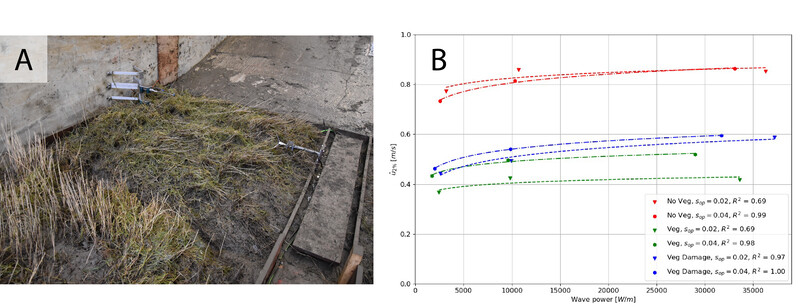J.R.M. Muller1*, D. De Graaf1 , E.E. Sirks2, J.J. van der Werf1,3, B.W. Borsje1, S.J.M.H. Hulscher1
1 University of Twente, the Netherlands; 2 Witteveen+Bos, the Netherlands; 3Deltares, the Netherlands
* Corresponding author: j.r.m.muller@utwente.nl
Introduction
Nature-based flood defences receive increasing interest as a viable option for improving flood safety worldwide. A contemporary case is using the ability of saltmarshes to attenuate waves during storm conditions for strengthening coastal flood defences (Vuik et al., 2016). Contrary to conventional coastal protection solutions, a saltmarsh is dynamic as it can erode. Although many research and observations has been done on saltmarsh dynamics, the erosion mechanics under extreme storm conditions are not well understood. Particularly at the transition between the saltmarsh and the coastal structure such as a sea dike, wave forcing and potential scouring at the toe of the dike pose a serious threat for the overall flood safety. Detailed observations on the near-bed velocities, the interaction with vegetation and erosion of a saltmarsh in front of a dike during storm conditions are missing.
Objective and Methods
In this work, we quantify the wave-driven near-bed velocities at the toe of a dike fronted by a saltmarsh with specific attention to the role of degrading vegetation and focusing on the erosion at the toe during extreme storm conditions.
The experiment was performed in the Deltaflume at Deltares. A real-life saltmarsh (70 m long) was created by harvesting blocks at a field site at the Dutch Wadden sea during Autumn. At the end of the model, a non-erodible dike was built with a slope of 1:3.6, typical for a Dutch coastal sea dike.
Irregular wave scenarios ranged from intermediate to extreme storm conditions, with significant wave heights (Hs,0) between 0.75 to 2.0 m at an offshore water depth between 4.4 to 6.9 m, corresponding to 1.5 to 4.0 m water depth on the marsh respectively. The wave scenarios were repeated as the vegetation (Elymus athericus) gradually got damaged and was finally removed by mowing. In total, the experiment covers 40 hours of exposure.
Near-bed velocities at the dike toe were measured by Acoustic Doppler Velocimeter (ADV) (Fig. 1a). Wave characteristics were measured with wave gauges. Erosion at the toe was monitored in between wave scenarios when the flume was drained.
Results
After approximately 40 hours of exposure, minimal erosion was observed at the toe of the dike. Even under extreme wave conditions (Hs,0 = 2.0 m), where heavy wave breaking occurred on the dike slope, scouring at the toe remained negligible (see Figure, Panel A).
Stronger wave conditions increased maximum near-bed velocities at the dike toe (û2%), ranging from 0.4 to 0.5 m/s for wave heights (Hs,0) between 0.75 m and 2.0 m for fully intact vegetation. The presence of vegetation effectively reduced these near-bed velocities (see Figure, Panel B). As the vegetation was gradually damaged, stems and leaves still provided wave attenuation. After full vegetation removal, û2% increased to 0.7 to 0.9 m/s, indicating a 50% reduction in near-bed velocities at the toe due to the vegetation presence. Attenuation of the velocities was higher for longer waves scenarios (sop = 0.04) compared to shorter waves (sop = 0.02).
Our findings extend previous research on maximum near-bed velocities (Spencer et al., 2016). Even under extreme storm conditions for an extensive period of exposure, these velocities did not exceed the critical threshold required for significant erosion at the toe. These results demonstrate the stability of the transition between a saltmarsh in front of a sloped coastal structure even during extreme conditions.

State of the saltmarsh at the toe of the dike after ca. 20 hours of wave exposure with the ADV deployed at the right side of the block (panel A) and maximum near-bed velocities for different states of the vegetation (panel B)
References
- Vuik, V., Jonkman, S. N., Borsje, B. W., & Suzuki, T., (2016), Nature-based flood protection:
The efficiency of vegetated foreshores for reducing wave loads on coastal dikes.
Coastal Engineering, 116, 42–56. - Spencer, T. , Möller, I., Rupprecht, F., Bouma, T. J., van Wesenbeeck, B. K., Kudella, M., Paul, M., Jensen, K., Wolters, G., Miranda-Lange, M., & Schimmels, S., (2016), Salt marsh surface sur-vives true-to-scale simulated storm surges. Earth Surf. Process. Landforms 41, 543–552.


